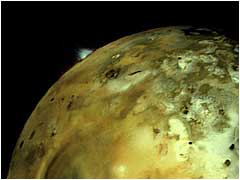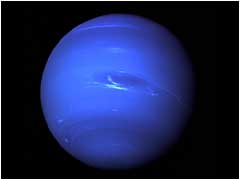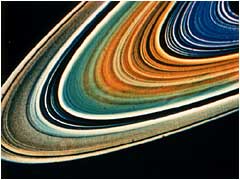 |
 |

An image of Jupiter taken by Voyager 2(Courtesy of NASA)


An image of volcanoes on Jupiter's satellite, Io, taken by Voyager 1(Courtesy of NASA)


An image of Neptune taken by Voyager 2(Courtesy of NASA)


An false-color image of Saturn's ring taken by Voyager 2(Courtesy of NASA)
 |
|
 |
 |
 |
 |
 |


NASA's planetary probe Voyager. In 1977, Voyager 2 spacecraft was launched on August 20 followed by Voyager 1 spacecraft on September 5. Both have explored the planets farther than Jupiter, and returned many great discoveries. Both still continue their adventures, and Voyager 1 has entered the solar system's final frontier.(Courtesy of NASA) |
 |

What kind of a mission is the Voyager mission?
Voyager is true exploration - discovering things that we hadn't even known we didn't know. Every planet we visited, we were surprised, because we were seeing things we hadn't imagined. That was true at Jupiter, Saturn, Uranus and Neptune. Voyager has a very large radio antenna, which continuously transmits radio data back to Earth. And we have antennas in three locations around the Earth - here in California, in Spain, and in Australia - which can listen to those signals. And we listen every day as Voyager tells us what's out there as we approach the edge of interstellar space.
Interstellar space is where the bubble the sun creates around itself, called the heliosphere, finally runs into the interstellar wind, which comes from the explosion of other stars. The boundary of the bubble is known as the heliopause, where the sun's solar wind is stopped by the interstellar wind, and this can be considered an outer border of the solar system. We think that boundary is 130-150 AU. [1 AU = 149.6 million kilometers.] But we want to know for sure. That's something this mission intends to explore and find out how large this bubble is.
What are some of the especially wonderful results of the Voyager mission?
Voyager of course was a big step forward over the missions that we had flown before that. It had three computers on board, which was the first time a spacecraft had been run totally by computers, back in the early 1970s. And that gave us the crucial capability to redesign Voyager each step of the way. As we went further and further out in the solar system, we could reprogram the spacecraft. We could change the system on the ground listening to Voyager, so we could continue to expand Voyager's reach well beyond that which was originally intended.
In fact, when we launched Voyager in 1977, we had no capability to return any images from Neptune. By the time we got to Neptune in 1989, we had learned how to change the spacecraft and how to improve the ground system, so that we could return those incredible images. Neptune is at 30 AU, 30 astronomical units, and Jupiter is at five. That's a factor of six in distance, resulting in a factor of 36 in the lower amount of sunlight at Neptune and 36 times weaker signal coming back from Neptune.
I think what the two Voyager spacecraft did was show us how diverse the bodies are in the solar system. Although they share many of the common physical properties, they look dramatically different. So we've learned the solar system is remarkably diverse. We learned that it's not only Earth that has active volcanoes, that even a small moon of Jupiter has a hundred times more volcanic activity than Earth. We learned that the rings of Saturn are very young, probably the break up of smaller moons that were once there.
Voyager has been the ultimate mission of discovery. It has seen more bodies for the first time than probably any spacecraft in the future ever will.
|
 |
|